Choosing the appropriate drum set is a critical decision for any aspiring drummer, whether one is a beginner or seeking to upgrade their current equipment.
This guide provides comprehensive information, covering essential aspects such as the various components, including drums, cymbals, and necessary hardware, as well as considerations such as budget, skill level, and musical preferences.
Furthermore, it discusses methods for evaluating and testing different drum sets, offers advice on purchasing used options judiciously, and provides guidance on maintaining equipment to ensure optimal performance.
Prepare to identify the ideal drum set that aligns with your musical style and aspirations.
Understanding Drum Set Components
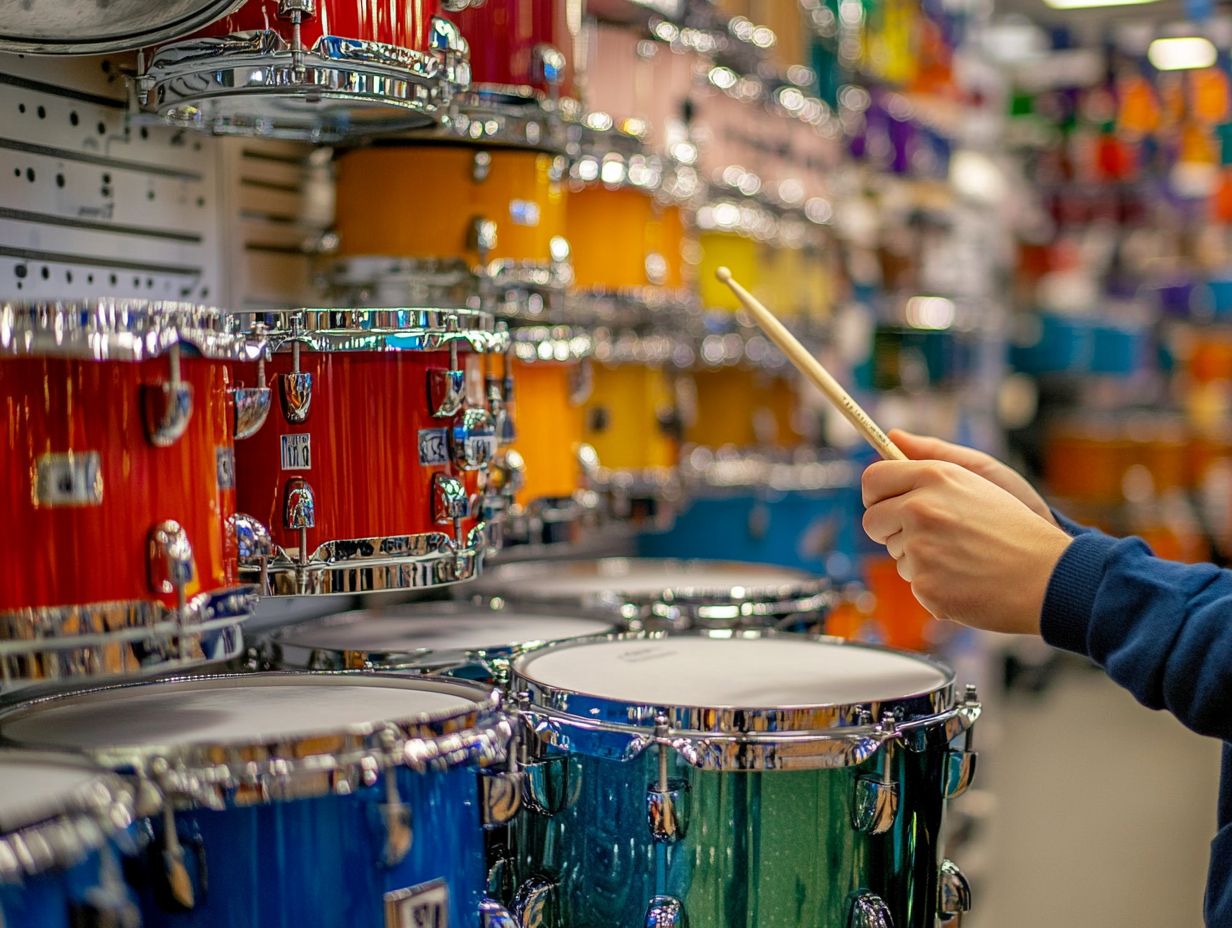
Understanding the components of a drum set is essential for individuals interested in drumming, whether they are beginners contemplating their first purchase or experienced players aiming to enhance their kit.
A typical drum set comprises various elements, including the bass drum, snare drum, toms, floor tom, cymbals, and necessary drum hardware. Each component contributes uniquely to the overall sound and playability of the drum kit, influencing aspects such as sound quality, portability, and setup.
By familiarizing oneself with these parts, individuals can make informed decisions when selecting a drum set that aligns with their performance needs and preferences.
Types of Drums and Cymbals
There exists a diverse array of drums and cymbals, each tailored to accommodate various musical styles and individual player preferences. Therefore, the selection of a drum set is a significant consideration for any drummer.
Acoustic kits, such as the Yamaha Stage Custom and the Pearl Export, produce rich rhythms that resonate beautifully in live performances, serving as the foundational element in genres such as rock, jazz, and blues. Each component of the kit, particularly the snare drum’s distinct crack and the bass drum’s resonant thump, contributes uniquely to the overall sound, thereby enhancing musical expression.
In contrast, electronic drums, including the Roland TD-27 and Alesis Nitro Mesh, provide a broad range of sounds and effects, enabling drummers to seamlessly transition across different genres, from pop to electronic dance music.
The capacity to customize sounds and the availability of headphone connections render these kits particularly suitable for practice and home recording. Thus, understanding the nuances between both types of drum sets is essential when selecting the most appropriate option for one’s musical endeavors.
Additional Hardware and Accessories
Along with the primary components of a drum set, various hardware and accessories are essential for optimizing the drumming experience and enhancing performance.
Key drum hardware includes robust stands for cymbals and toms, foot pedals for the bass drum, and hi-hat stands that facilitate a range of playing techniques. Accessories such as drumsticks, practice pads, and educational resources like online tutorials can significantly improve practice sessions. Recognizing the importance of each piece of hardware is vital for creating a well-rounded setup that aligns with one’s playing style and preferences.
For beginners, selecting the appropriate foot pedal can greatly influence rhythm and responsiveness; thus, it is advisable to test different models to ensure comfort and durability. Similarly, adjustable stands are crucial for positioning each component correctly to achieve optimal playability, while high-quality drumsticks can enhance both sound and technique.
Practice pads provide a quiet and portable solution for developing skills, making them invaluable for practicing in various settings. Engaging with tutorials and instructional videos can further reinforce fundamental techniques, guiding novices through the essential practices necessary for becoming proficient drummers.
Investing in reliable accessories not only complements the overall setup but also contributes to a more enjoyable and effective learning experience.
Factors to Consider When Choosing a Drum Set
When selecting a drum set, several critical factors must be considered, as they can significantly influence overall satisfaction and performance as a drummer.
One of the primary considerations is the budget, which will determine whether one prioritizes new drum sets or explores the second-hand market for used options that may meet specific requirements.
Furthermore, the drummer’s skill level—whether a beginner, intermediate, or advanced player—will affect the type of kit that should be contemplated.
Additional elements, such as sound quality, brand reputation, and warranty, are also essential in ensuring that the investment is prudent and aligns with long-term drumming goals.
Budget and Skill Level
When selecting a drum set, two significant factors to consider are the budget and skill level, as these elements directly influence the available options and potential investment in drumming equipment.
Beginners typically seek affordable drum sets that provide decent sound quality while allowing for future growth. In contrast, intermediate and advanced players may pursue more specialized kits tailored to their individual playing styles and preferences. By understanding the price range of various options and aligning it with one’s skill level, individuals can make informed decisions that will support their drumming journey.
For beginners, drum kits priced between $300 and $500 generally offer a well-balanced combination of affordability and quality, providing essential components without overwhelming the player.
Intermediate drummers may consider options ranging from $600 to $1,200, which typically feature enhanced materials and sound versatility, enabling a broader range of musical expression.
Advanced players often opt for premium kits priced from $1,500 and above, which frequently showcase high-end craftsmanship and customization possibilities.
When evaluating used drum sets, it is crucial to conduct a thorough assessment of their condition, paying close attention to the wear on drum heads, the functionality of hardware, and the overall integrity of the shells. A well-maintained used kit can represent a valuable investment if it meets the desired tonal and structural criteria.
Music Genre and Personal Preferences
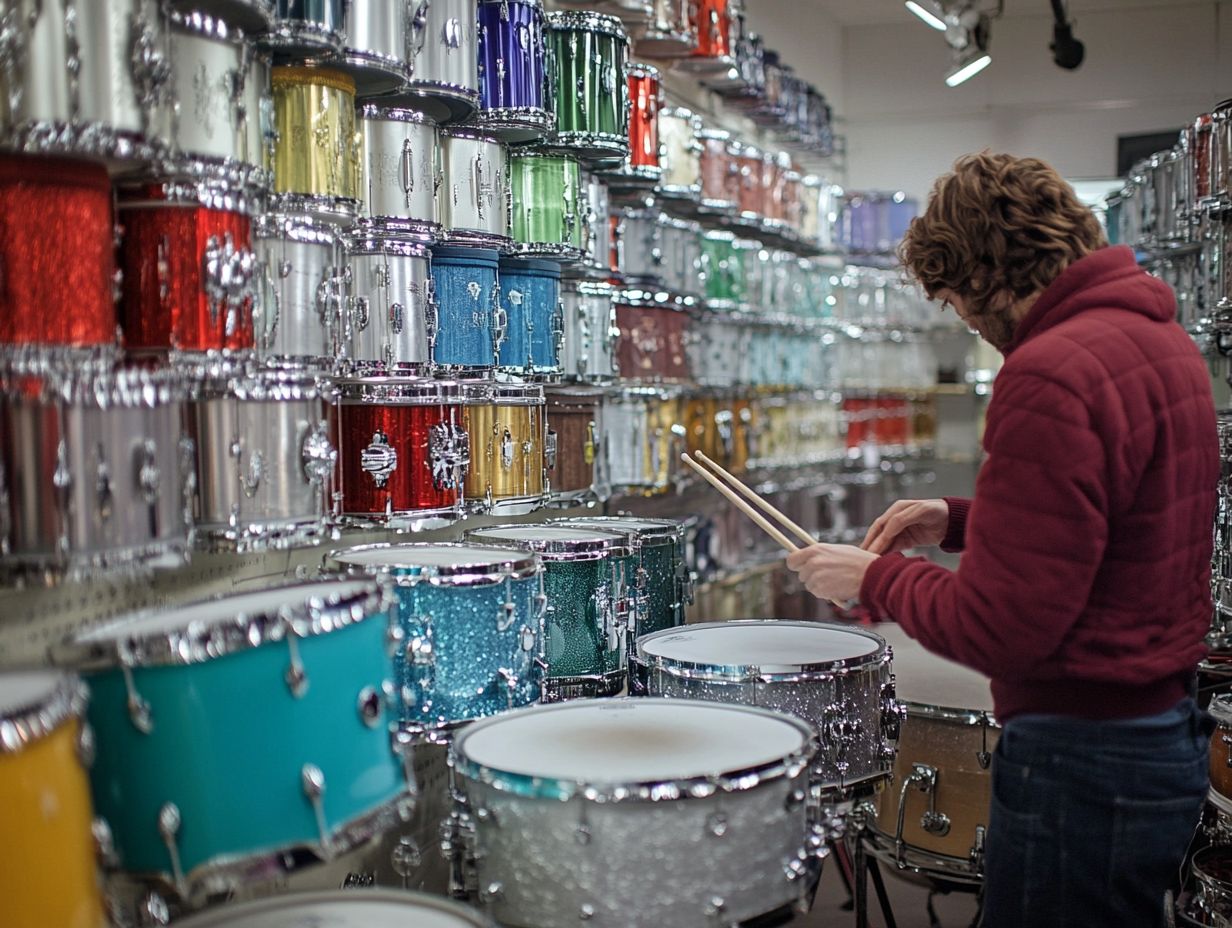
The music genre one intends to play, along with personal preferences, significantly influences the selection of an appropriate drum set, as different genres often necessitate distinct sounds and drumming techniques.
For example, jazz drummers may prefer a smaller, more portable acoustic kit, while rock drummers are likely to choose larger, more powerful setups that incorporate various cymbals and toms. A thorough understanding of the cultural influences and stylistic elements associated with the chosen music genre can assist in identifying a drum set that complements one’s playing style and enhances overall performance.
It is important to recognize that, in addition to the genre, factors such as color preferences and ergonomics are crucial considerations in the decision-making process.
For instance, a vibrant red finish may appeal to a funk drummer seeking to make a bold statement on stage, while a classic natural wood stain might resonate more with a blues enthusiast. Moreover, ergonomic factors such as the height and angle of the drum kit can significantly influence comfort during extended practice sessions or performances, ultimately impacting how a musician conveys their artistic expression.
Testing and Evaluating Drum Sets
Testing and evaluating drum sets prior to making a purchase is crucial for ensuring that the selected kit aligns with one’s expectations regarding sound quality and playability.
When examining various brands and models, it is imperative to assess how each drum set performs in terms of feel and sound, as these characteristics can vary significantly among manufacturers and styles.
Furthermore, reading reviews and seeking recommendations from fellow drummers can contribute to refining one’s selection and identifying models that adequately meet specific performance needs and preferences.
Trying Out Different Brands and Models
When evaluating various brands and models of drum sets, it is essential to consider specific features and craftsmanship that can significantly impact the playing experience. Each brand may offer distinctive construction methods, shell materials, and setup options that contribute to the overall sound isolation and quality of the kit.
By meticulously testing different models, one can gain a deeper understanding of their characteristics and identify the drum set that aligns best with individual preferences and performance requirements.
For instance, it is important to recognize how the thickness and type of shell material—such as birch, maple, or sintered steel—can generate unique tonal qualities. The craftsmanship of the hardware and the precision in assembly play a vital role in determining the durability and playability of the kit.
Additionally, observing how various setups influence sound projection and resonance is crucial for a comprehensive evaluation.
It is advisable to take adequate time during assessments. Pay close attention to the sound, feel the response of each drum, and note how they resonate collectively as a complete set.
By adopting a deliberate approach in this evaluation process, one is not only more likely to find the ideal drum set but also to enhance overall musical expression.
Assessing Sound Quality and Playability
Assessing sound quality and playability is paramount when evaluating potential drum sets, as these two elements significantly influence the overall drumming experience.
Factors such as tuning, shell material, and drum head selection contribute to the sound produced by a drum kit, making it essential to consider these aspects during the evaluation process. A comprehensive understanding of how the setup impacts playing techniques will aid in selecting a drum set that feels comfortable and aligns with one’s performance style.
For example, the choice between coated and clear drum heads can dramatically affect tonal quality, influencing various factors from sustain to attack. Fine-tuning each drum can enhance resonance and projection, making it vital to experiment with different tunings to ascertain what resonates best with one’s personal style.
Moreover, the physical layout of the drums is of significant importance; an ergonomic setup can enhance mobility and responsiveness, enabling the execution of complex rhythms with greater ease. Ultimately, the appropriate drum set not only improves sound quality but also fosters creativity through enhanced playability.
Tips for Buying a Used Drum Set
Purchasing a used drum set can be a highly effective way to acquire quality equipment at a lower cost; however, it necessitates careful consideration to ensure a prudent investment.
When assessing pre-owned gear, it is essential to understand the key aspects to evaluate, including condition, setup, and playability.
Factors such as maintenance history, resale value, and brand reputation play a significant role in guiding the decision-making process within the second-hand market, enabling you to avoid potential pitfalls and select a drum kit that aligns with your requirements.
What to Look for and What to Avoid
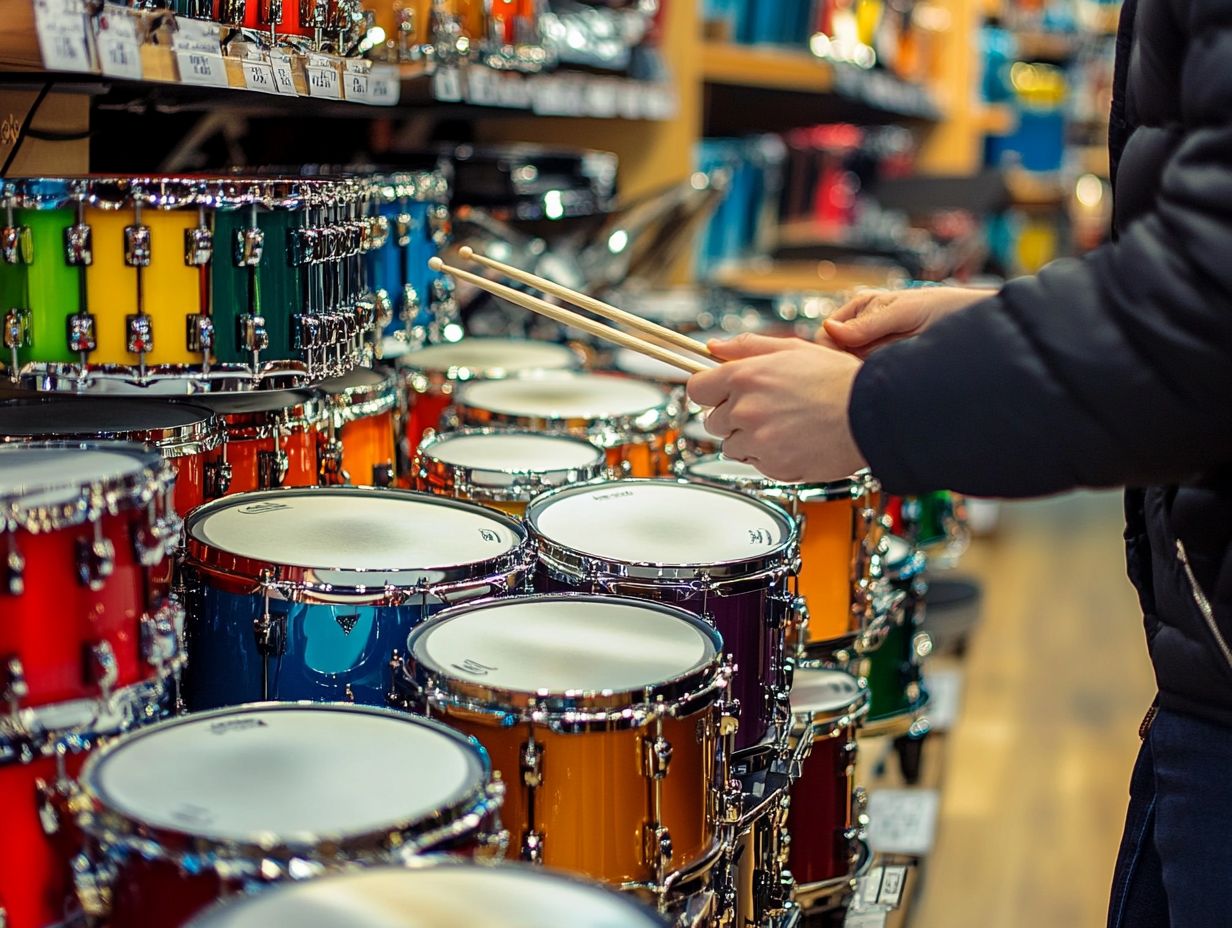
When purchasing a used drum set, understanding what to seek and what to avoid can conserve both time and financial resources while ensuring a satisfactory acquisition. Important factors to consider include the overall sound quality of the kit, the brand’s reputation, and the availability of warranties or customer support.
Exercising caution regarding kits that exhibit signs of significant wear or have components that lack proper maintenance can help mitigate costly errors.
Sound quality is of utmost importance; therefore, it is prudent to listen for any unusual noises or tuning inconsistencies during a trial play. Established brands typically have a proven track record of producing durable and resonant kits, which can significantly enhance the musical experience.
When evaluating a used drum set, it is advisable to inquire about previous ownership and usage to gain insights into its condition. Kits with faded finishes or rusted hardware should be avoided, as these may indicate a lack of proper care.
Additionally, it is essential to ask about replacement parts, as compatibility can pose challenges with older models.
By remaining vigilant regarding these specific indicators, one can make a more informed decision and enjoy the instrument for many years to come.
Setting Up and Maintaining Your Drum Set
Establishing and maintaining a drum set appropriately is crucial for achieving optimal performance and ensuring the longevity of the equipment.
Proper assembly of components, including the positioning of the bass drum, snare drum, toms, and cymbals, can significantly enhance playability and sound quality. Furthermore, regular maintenance practices, such as tuning drum heads, assessing hardware stability, and employing soundproofing techniques, will ensure that the drum kit remains in peak condition, thereby facilitating an enjoyable playing experience.
Proper Assembly and Care
The proper assembly and maintenance of a drum set are critical factors that significantly influence its performance and the comfort of the player. It is essential to ensure that each component is correctly arranged, from the positioning of the bass drum to the layout of the cymbals.
This attention to detail enhances the ergonomic experience and supports improved playing techniques. Implementing regular maintenance routines—such as inspecting drum hardware and ensuring the stability of stands and pedals—will extend the lifespan of the kit and preserve its sound quality.
This entails careful consideration of the height and angle of each drum and cymbal, ensuring they are easily accessible without inducing strain. It is advisable to begin by adjusting the throne to a suitable height, thereby promoting a natural posture and facilitating fluid movement.
When arranging the drums, a semicircular layout that aligns comfortably with the musician’s reach is recommended.
Additionally, it is important to periodically clean the hardware to prevent the accumulation of rust and grime, which can negatively impact performance over time. Simple practices, such as tightening loose components and using a soft cloth to wipe down surfaces after each session, will help maintain the equipment in optimal condition.
Frequently Asked Questions
How do I know what size drum set to choose?
The size of the drum set depends on the type of music you will be playing and your personal preference. If you are playing rock or pop music, a standard 5-piece set will suffice. Jazz and fusion drummers may prefer a smaller 4-piece set. It is best to try out different sizes to see which feels most comfortable for you.
What materials should I look for in a drum set?
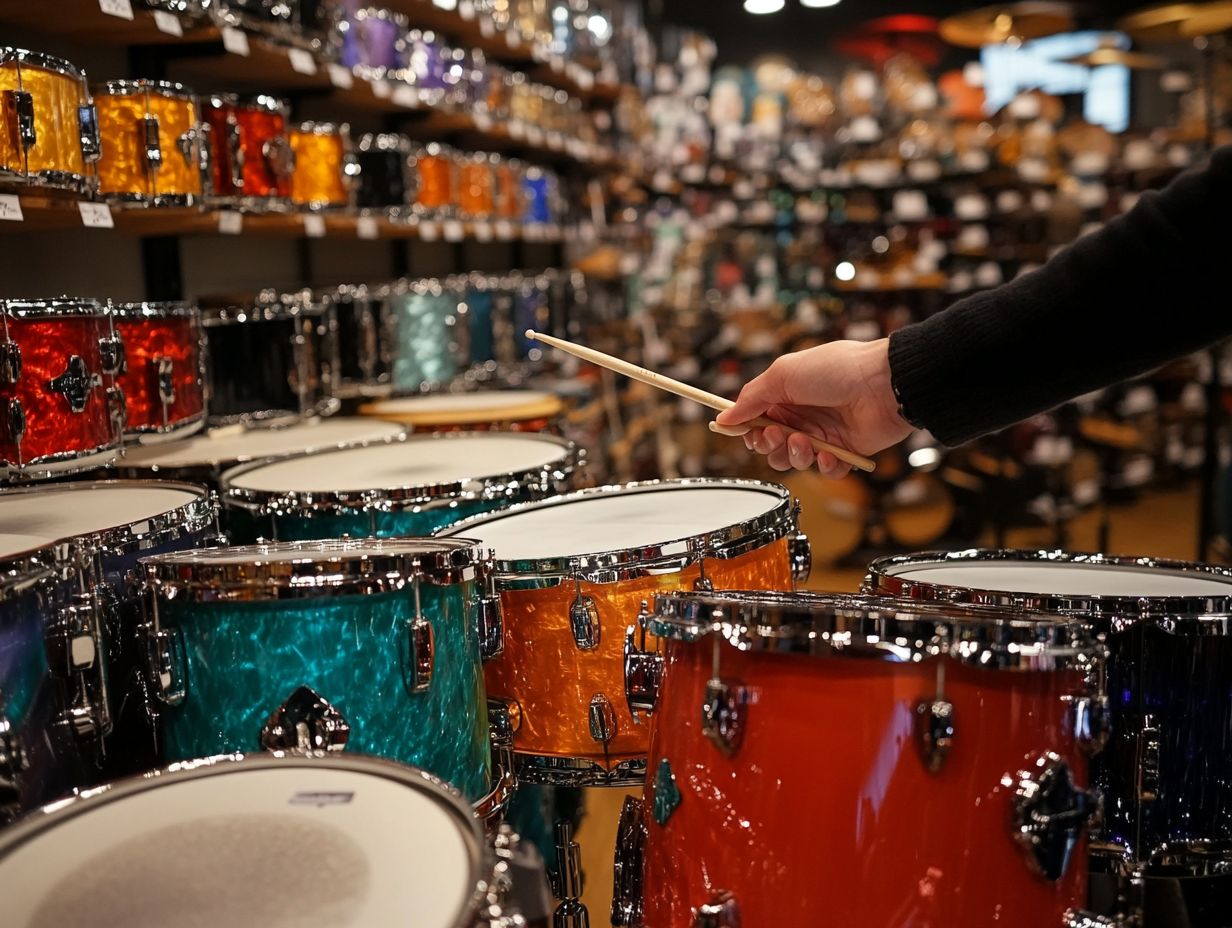
The most common materials for drum shells are wood, acrylic, and metal. Each material has its own unique sound and characteristics. For a warm and classic sound, go for wood shells. For a brighter and more modern sound, acrylic or metal shells may be a better choice. Keep in mind that different drum manufacturers may use different types of wood, so it’s best to try out different sets to see which sound you prefer.
What type of cymbals should I choose for my drum set?
When choosing cymbals, it is important to consider the type of music you will be playing. For rock and pop, a standard set of hi-hats, crash, and ride cymbals will suffice. Jazz and fusion drummers may prefer a wider variety of cymbals such as splashes, chinas, and effects cymbals. It’s best to try out different cymbals to find the ones that complement your playing style.
Should I buy a drum set with hardware included?
It is common for drum sets to come with basic hardware such as cymbal stands and a drum throne. However, if you plan on upgrading your hardware in the future, it may be better to buy a drum set without hardware and invest in better quality hardware separately. This can also save you money in the long run as you won’t have to replace the basic hardware that came with the set.
What is the difference between a junior and a full-size drum set?
A junior drum set is typically smaller in size and designed for younger or smaller drummers. They usually come with fewer drums and cymbals, but are a more affordable option for beginners. Full-size drum sets are larger and have a wider range of drums and cymbals, making them suitable for more advanced drummers and a wider range of musical styles.
Is it better to buy a drum set in a store or online?
While it may be more convenient to buy a drum set online, it is highly recommended to try out the set in person before purchasing. This will allow you to get a feel for the drums and cymbals, as well as test the sound and quality. If you do decide to buy online, make sure to read reviews and do thorough research to ensure you are getting a quality product.

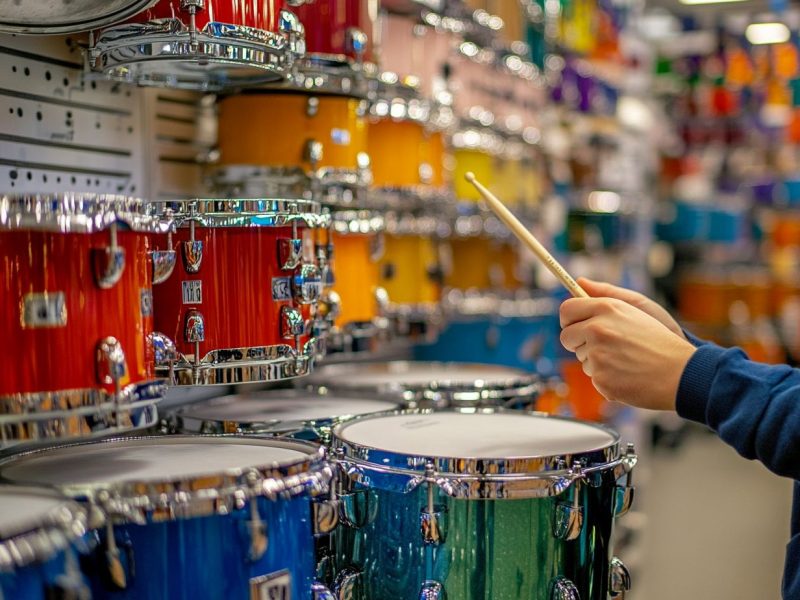
 Discover the Top Microphones for Your Home Studio Setup
Discover the Top Microphones for Your Home Studio Setup